Baltimore riots: Why it's not 1968
Loading...
| Baltimore
Baltimore is not burning down.
Yes, you’ve been watching the news and it sure looks like the city was aflame. Residents frustrated by deep racial and economic divisions that cracked open long ago were throwing stones at police. Opportunists were smashing store windows and looting what they can carry. Fire crews were dousing small businesses struck by arson.
But the focus of cameras is narrow and bright. On Monday, the violence was scattered in areas across the city. It is not 1968, where rioting engulfed whole sections and set back Baltimore for generations. It is not a series-ending finale of “The Wire,” with gangs rising to take over City Hall.
“What’s so disturbing is that the news gives people the impression the entire city was in chaos, which wasn’t the case,” says Elizabeth Nix, an assistant professor of legal, ethical, and historical studies at the University of Baltimore and co-editor of a book on the ’68 riots. “But with social media, people see these images over and over, and they get conflated with fictional depictions of the city.”
Ms. Nix has lived in Baltimore for 20 years, much of that time on Union Square, former home of famed journalist H.L. Mencken. She’s helped found a city charter school and sent her own kids to public schools.
“It is just very sad,” she says of the events of recent days. “It is heartening today to see all the groups of people coming out, all kinds of people cleaning up.”
The 1968 riots destroyed more than 1,000 businesses. Six people died over the course of eight days of violence. Yet city officials never really examined the causes of the social unrest. Baltimore’s long, slow decline continued.
“I’m hopeful that isn’t the case today,” says Nix.
One contrast: No one was killed in Monday night's violence, which erupted after the funeral of Freddie Gray, who died after injuries sustained in police custody.
Lord knows the city has big problems. Whole blocks of East Baltimore are unoccupied. Police commissioners come and go on a regular basis, whipsawing department policy. The current commissioner, Anthony Batts, is a California transplant who arrived in 2012. In February, he made news by saying he was surprised at the “1950s racism” he’d encountered in his new job.
Mayors come and go, too. The most recent previous mayor was Sheila Dixon, a savvy former teacher and strong leader who was also, unfortunately, a crook. She was convicted in 2009 of stealing gift cards intended for distribution to needy families.
But if the leadership has been inconsistent, the Patapsco River is always there. Baltimore’s waterfront vistas are a boon and an economic draw. Million-dollar condos line the Federal Hill, Fells Point, and Canton neighborhoods. The water draws corporate headquarters like Under Armour’s Tide Point campus.
The city’s historic neighborhoods and vibrant night life are a big draw for Millenials looking for “authenticity” in their residence of choice. Its proximity to Washington means some of the money that’s washed through the nation’s capital in recent decades sloshes up here. The school system is challenged as a whole, but Baltimore still has some of the best individual public high schools in America, which produce such national leaders are Rep. Elijah Cummings (D) of Maryland, who spoke Monday at Freddie Gray’s funeral.
The city’s resilience is reflected in the very places where rioting has occurred.
Much of the action on Monday took place near Mondawmin Mall, a sprawling shopping center on Liberty Heights Avenue west of Druid Hill Park. Mondawmin was developed in the 1950s by James Rouse, a visionary city planner instrumental in busting the restrictive racial covenants of some North Baltimore neighborhoods. More recently it’s been rebuilt with a Target and other new store as a mid-city shopping oasis.
Other looting hit stores near the Inner Harbor. That’s long been the face of Baltimore’s national image, but at this point it’s not just the harbor area but a miles-long waterfront area that stretches from the iconic Camden Yards stadium on the west to the high-rises and restaurants of Harbor East, next to Little Italy.
Shops were smashed and burned on the East Side near Johns Hopkins Hospital, too.
Baltimore has public health problems. Its infant mortality rate is high, for instance. But Hopkins is a world-class hospital located in a high-poverty area that treats all comers. It is the centerpiece of a regional medical economy that provides thousands of jobs for Baltimoreans, from doctors and nurses to receptionists and maintenance crews.
Maybe arson and looting will cripple these places. That’s possible. It’s possible unrest will spread and consume whole neighborhoods. On Tuesday, though, volunteers were out cleaning up and relative calm prevailed.
The British bombarded Fort McHenry and tried to burn the city in 1814. It didn’t work then. And in 2015 when the violence cools and the camera crews depart, Baltimore will still be there.






